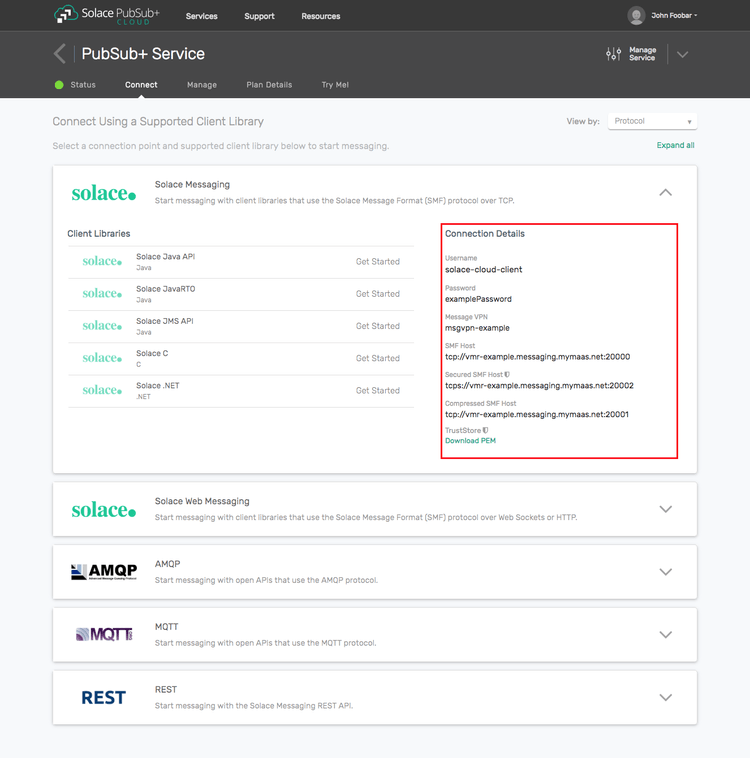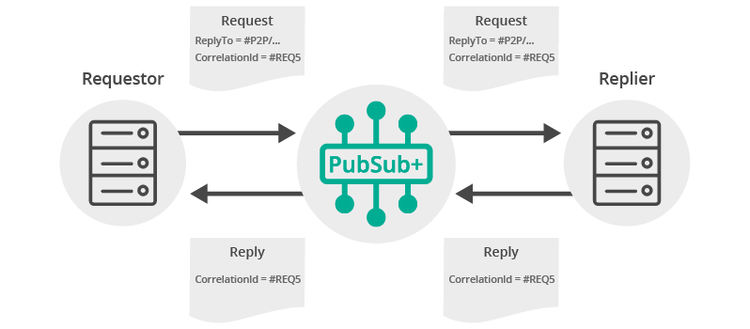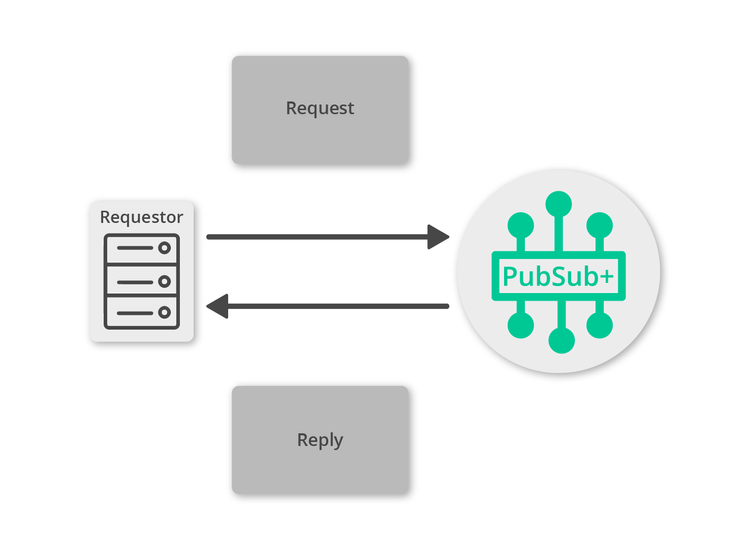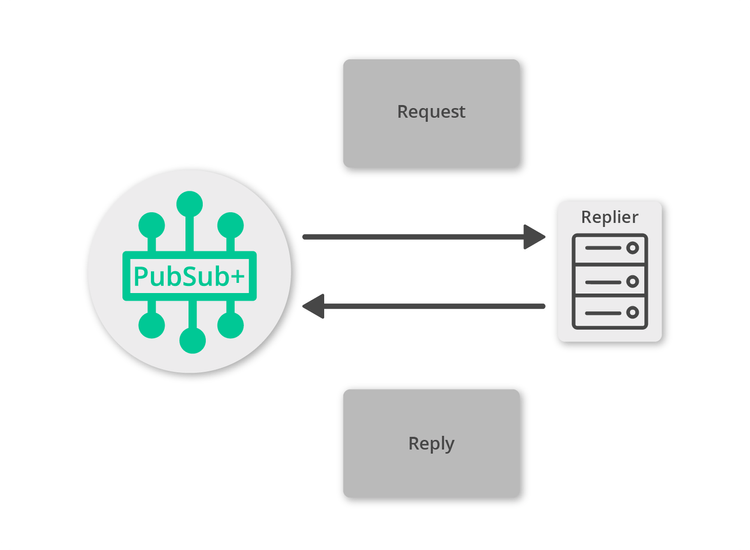Request/Reply
7 Minute Read
This tutorial outlines both roles in the request-response message exchange pattern. It will show you how to act as the client by creating a request, sending it and waiting for the response. It will also show you how to act as the server by receiving incoming requests, creating a reply and sending it back to the client. It builds on the basic concepts introduced in publish/subscribe tutorial.
Assumptions
This tutorial assumes the following:
-
You are familiar with Solace core concepts.
-
You have access to Solace messaging with the following configuration details:
- Connectivity information for a Solace message-VPN
- Enabled client username and password
One simple way to get access to Solace messaging quickly is to create a messaging service in Solace Cloud as outlined here. You can find other ways to get access to Solace messaging below.
Goals
The goal of this tutorial is to understand the following:
- On the requestor side:
- How to create a request
- How to receive a response
- How to use the Solace API to correlate the request and response
- On the replier side:
- How to detect a request expecting a reply
- How to generate a reply message
Overview
Request-reply messaging is supported by the Solace message router for all delivery modes. For direct messaging, the Solace APIs provide the Requestor object for convenience. This object makes it easy to send a request and wait for the reply message. It is a convenience object that makes use of the API provided “inbox” topic that is automatically created for each Solace client and automatically correlates requests with replies using the message correlation ID. (See Message Correlation below for more details). On the reply side another convenience method enables applications to easily send replies for specific requests. Direct messaging request reply is the delivery mode that is illustrated in this sample.
It is also possible to use guaranteed messaging for request reply scenarios. In this case the replier can listen on a queue for incoming requests and the requestor can use a temporary endpoint to attract replies. The requestor and replier must manually correlate the messages. This is explained further in the Solace documentation and shown in the API samples named RRGuaranteedRequestor and RRGuaranteedReplier.
Message Correlation
For request-reply messaging to be successful it must be possible for the requestor to correlate the request with the subsequent reply. Solace messages support two fields that are needed to enable request-reply correlation. The reply-to field can be used by the requestor to indicate a Solace Topic or Queue where the reply should be sent. A natural choice for this is often the unique P2PINBOX_IN_USE topic which is an auto-generated unique topic per client which is accessible as a session property. The second requirement is to be able to detect the reply message from the stream of incoming messages. This is accomplished using the correlation-id field. This field will transit the Solace messaging system unmodified. Repliers can include the same correlation-id in a reply message to allow the requestor to detect the corresponding reply. The figure below outlines this exchange.
For direct messages however, this is simplified through the use of the Requestor object as shown in this sample.
Get Solace Messaging
This tutorial requires access Solace PubSub+ messaging and requires that you know several connectivity properties about your Solace messaging. Specifically you need to know the following:
| Resources | Value | Description |
|---|---|---|
| Host | String | This is the address clients use when connecting to the PubSub+ messaging to send and receive messages. (Format: DNS_NAME:Port or IP:Port) |
| Message VPN | String | The PubSub+ message router Message VPN that this client should connect to. |
| Client Username | String | The client username. (See Notes below) |
| Client Password | String | The client password. (See Notes below) |
There are several ways you can get access to PubSub+ Messaging and find these required properties.
Option 1: Use PubSub+ Cloud
-
Follow these instructions to quickly spin up a cloud-based PubSub+ messaging service for your applications.
-
The messaging connectivity information is found in the service details in the connectivity tab (shown below). You will need:
- Host:Port (use the SMF URI)
- Message VPN
- Client Username
- Client Password

Option 2: Start a PubSub+ Software
-
Follow these instructions to start the PubSub+ Software in leading Clouds, Container Platforms or Hypervisors. The tutorials outline where to download and how to install the PubSub+ Software.
-
The messaging connectivity information are the following:
-
Host: <public_ip> (IP address assigned to the VMR in tutorial instructions)
-
Message VPN: default
-
Client Username: sampleUser (can be any value)
-
Client Password: samplePassword (can be any value)
Note: By default, the PubSub+ Software "default" message VPN has authentication disabled.
-
Option 3: Get access to a PubSub+ Appliance
-
Contact your PubSub+ appliance administrators and obtain the following:
- A PubSub+ Message-VPN where you can produce and consume direct and persistent messages
- The host name or IP address of the Solace appliance hosting your Message-VPN
- A username and password to access the Solace appliance
Obtaining the Solace PubSub+ API
The latest versions of all Solace APIs can be downloaded from the solace downloads page. Otherwise, check the public samples repository of the API where the library is already packaged as a gzipped tar file. Note: always check for the latest API version!
Connecting a session to the message router
As with other tutorials, this tutorial requires a JCSMPSession connected to the default message VPN of a Solace VMR which has authentication disabled. So the only required information to proceed is the Solace VMR host string which this tutorial accepts as an argument. Connect the session as outlined in the publish/subscribe tutorial.
Making a request
First let’s look at the requestor. This is the application that will send the initial request message and wait for the reply.
For convenience, we will use the Requestor object that is created from the Session object. The Requestor object makes use of the Session’s Producer and Consumer objects to send messages and receive replies. So in order for the Requestor to function correctly, there must be a Producer and Consumer created within the session. Normally this will already be done by other parts of the application. However, for demonstration purposes, the simplest was to accomplish this is show below.
// Simple anonymous inner-class for handling publishing events
session.getMessageProducer(new JCSMPStreamingPublishCorrelatingEventHandler() {
// unused in Direct Messaging application, only for Guaranteed/Persistent publishing application
@Override public void responseReceivedEx(Object key) {
}
// can be called for ACL violations, connection loss, and Persistent NACKs
@Override
public void handleErrorEx(Object key, JCSMPException cause, long timestamp) {
System.out.printf("### Producer handleErrorEx() callback: %s%n", cause);
if (cause instanceof JCSMPTransportException) { // all reconnect attempts failed
isShutdown = true; // let's quit; or, could initiate a new connection attempt
}
}
});
// less common use of SYNChronous blocking consumer mode (null callback)
final XMLMessageConsumer consumer = session.getMessageConsumer((XMLMessageListener)null);
consumer.start(); // needed to receive the responsesNext you must create a message and the topic to send the message to. This is done in the same way as illustrated in the publish/subscribe tutorial.
final Topic topic = JCSMPFactory.onlyInstance().createTopic("tutorial/requests");
TextMessage request = JCSMPFactory.onlyInstance().createMessage(TextMessage.class);
final String text = "Sample Request";
request.setText(text);Finally create a Requestor object and send the request. This example demonstrates a blocking call where the method will wait for the response message to be received. Asynchronous is also possible. For this see the online API documentation for more details.
final int timeoutMs = 10000;
try {
Requestor requestor = session.createRequestor();
BytesXMLMessage reply = requestor.request(request, timeoutMs, topic);
} catch (JCSMPRequestTimeoutException e) {
System.out.println("Failed to receive a reply in " + timeoutMs + " msecs");
}If no response is received within the timeout specified (10 seconds in this example), then the API will throw a JCSMPRequestTimeoutException.
Replying to a request
Now it is time to receive the request and generate an appropriate reply.
Just as with previous tutorials, you still need to connect a session and subscribe to the topics that requests are sent on. However, in order to send replies back to the requestor, you will also need a Producer. The following is an example of the most basic producer.
final XMLMessageProducer producer = session.getMessageProducer(new JCSMPStreamingPublishEventHandler() {
@Override
public void responseReceived(String messageID) {
System.out.println("Producer received response for msg: " + messageID);
}
@Override
public void handleError(String messageID, JCSMPException e, long timestamp) {
System.out.printf("Producer received error for msg: %s@%s - %s%n", messageID, timestamp, e);
}
});Then you simply have to modify the onReceive() method of the XMLMessageConsumer to inspect incoming messages and generate appropriate replies. For example, the following code will send a response to all messages that have a reply-to field. This makes use of the XMLMessageProducer convenience method sendReply(). This method will properly copy the correlation-ID from the request to the reply and send the reply message to the reply-to destination found in the request message.
@Override
public void onReceive(BytesXMLMessage request) {
if (request.getReplyTo() != null) {
TextMessage reply =
JCSMPFactory.onlyInstance().createMessage(TextMessage.class);
final String text = "Sample response";
reply.setText(text);
try {
producer.sendReply(request, reply);
} catch (JCSMPException e) {
System.out.println("Error sending reply.");
}
} else {
System.out.println("Received message without reply-to field");
}
}Receiving the Reply Message
All that’s left is to receive and process the reply message as it is received at the requestor. If you now update your requestor code to match the following you will see each reply printed to the console.
try {
Requestor requestor = session.createRequestor();
BytesXMLMessage reply = requestor.request(request, timeoutMs, topic);
// Process the reply
if (reply instanceof TextMessage) {
System.out.printf("TextMessage response received: '%s'%n",
((TextMessage)reply).getText());
}
System.out.printf("Response Message Dump:%n%s%n",reply.dump());
} catch (JCSMPRequestTimeoutException e) {
System.out.println("Failed to receive a reply in " + timeoutMs + " msecs");
}Summarizing
The full source code for this example is available in GitHub. If you combine the example source code shown above results in the following source:
Getting the Source
This tutorial is available in GitHub. To get started, clone the GitHub repository containing the Solace samples.
git clone https://github.com/SolaceSamples/solace-samples-java-jcsmp
cd solace-samples-java-jcsmpBuilding
The build instructions in this tutorial assume you are using a Linux shell. If your environment differs, adapt the instructions.
Building these examples is simple. You can simply build the project using Gradle.
./gradlew assembleThis builds all of the Java Getting Started Samples with OS specific launch scripts. The files are staged in the build/staged directory.
Running the Sample
First start the BasicReplier so that it is up and listening for requests. Then you can use the BasicRequestor sample to send requests and receive replies.
$ ./build/staged/bin/basicReplier <host:port> <client-username>@<message-vpn> [client-password]
$ ./build/staged/bin/basicRequestor <host:port> <client-username>@<message-vpn> [client-password]With that you now know how to successfully implement the request-reply message exchange pattern using Direct messages.


